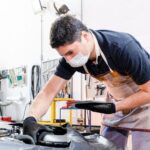Ever found yourself stranded with a dead car battery? It’s a real bummer, right? Often, the culprit isn’t the battery itself but the car battery terminals. These small yet vital components ensure that your car’s battery functions properly. Without them, your car isn’t going anywhere. In this article, we’ll dive into everything you need to know about car battery terminals, from what they are to how to maintain them. Buckle up!
What Are Car Battery Terminals?
Car battery terminals are the connection points that link your car’s battery to its electrical system. They come in two types: positive and negative. The positive terminal is usually marked with a plus sign (+) and is often larger than the negative terminal, which is marked with a minus sign (-).
Types of Car Battery Terminals
- Top Post Terminals: These are the most common type found in most vehicles. They sit on top of the battery.
- Side Post Terminals: Found on the side of the battery, these are often used in GM vehicles.
- Lug Terminals: These are flat, bolt-on terminals commonly used in marine and industrial applications.
- Quick Release Terminals: As the name suggests, these allow for quick and easy disconnection of the battery.
Why Are Car Battery Terminals Important?
Without properly functioning battery terminals, your car won’t start. They ensure a solid connection between the battery and the car’s electrical system, allowing electricity to flow smoothly. Faulty terminals can lead to a range of problems, from a dead battery to electrical malfunctions.
Common Issues with Car Battery Terminals
Corrosion
Corrosion is the enemy of car battery terminals. It appears as a white, ashy substance around the terminals and can interrupt the connection, leading to starting issues. Corrosion happens due to the release of hydrogen gas from the battery acid, which reacts with the metal terminals.
Loose Connections
Loose terminals can cause intermittent electrical problems, which can be frustrating and difficult to diagnose. Over time, vibrations from the car can loosen the terminal connections.
Worn-Out Terminals
Like any other component, battery terminals wear out over time. They can become brittle, cracked, or otherwise damaged, which can prevent a good connection.
How to Clean Car Battery Terminals
Cleaning your car battery terminals is a simple yet essential maintenance task. Here’s a step-by-step guide to get you started:
- Gather Supplies: You’ll need a wrench, baking soda, water, a brush (an old toothbrush works great), and some petroleum jelly.
- Safety First: Make sure your car is off. Disconnect the negative terminal first, followed by the positive terminal.
- Prepare the Cleaning Solution: Mix a tablespoon of baking soda with a cup of water.
- Clean the Terminals: Dip the brush in the baking soda solution and scrub the terminals and clamps until they’re clean.
- Rinse and Dry: Rinse the terminals with water and dry them thoroughly.
- Reconnect the Terminals: Connect the positive terminal first, followed by the negative terminal. Apply a small amount of petroleum jelly to the terminals to prevent future corrosion.
How to Replace Car Battery Terminals
If cleaning doesn’t solve your problem, you might need to replace the terminals. Here’s how:
- Disconnect the Battery: Start with the negative terminal, then the positive.
- Remove the Old Terminals: Use a wrench to remove the old terminals from the battery cables.
- Attach New Terminals: Connect the new terminals to the battery cables, making sure they’re tight and secure.
- Reconnect the Battery: Connect the positive terminal first, then the negative.
FAQs About Car Battery Terminals
How often should I check my car battery terminals?
It’s a good idea to check your battery terminals every time you change your oil or at least every six months. Regular checks can help prevent unexpected problems.
What causes car battery terminal corrosion?
Corrosion is caused by the release of hydrogen gas from the battery acid, which reacts with the metal terminals. This reaction creates a corrosive environment that can interfere with the connection.
Can I drive with corroded battery terminals?
It’s not advisable. Corroded terminals can lead to a weak connection, causing your car to have trouble starting or even stalling while driving.
How can I prevent car battery terminal corrosion?
Applying a thin layer of petroleum jelly to the terminals after cleaning them can help prevent corrosion. Also, regular maintenance and checks can keep corrosion at bay.
Are all car battery terminals the same?
No, there are different types of battery terminals, including top post, side post, lug, and quick release. Each type serves different applications and vehicles.
Conclusion
Understanding and maintaining your car battery terminals can save you from a lot of headaches. From ensuring a solid connection to preventing corrosion, a little bit of attention can go a long way. Remember, the key to a reliable vehicle starts with its battery terminals. Don’t wait until you’re stranded – take action now!
Authoritative Links
Here are some authoritative resources for more information on car battery terminals:
- https://www.autozone.com
- https://www.batteriesplus.com
- https://www.cars.com
- https://www.consumerreports.org
- https://www.familyhandyman.com
By following these guidelines and tips, you’ll keep your car’s electrical system in top shape and avoid unexpected breakdowns.







